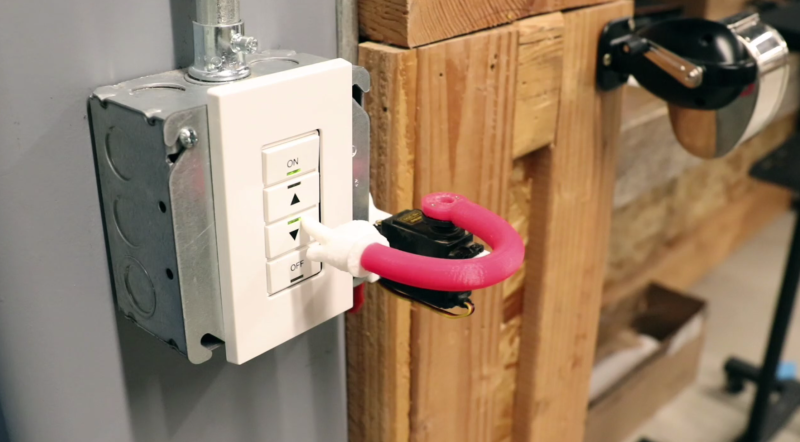While WiFi controlled lights are readily available, replacing your lighting fixtures or switches isn’t always an option. [Thomas] ran into this issue with his office lights. For the developers in the office, these lights always seemed to run a little too bright. The solution? A 3D printed, WiFi controlled finger to poke the dimmer switch.
This little hack consists of a servo, a 3D printed arm and finger assembly, and a Wemos D1 Mini development board. The Wemos is a low cost, Arduino compatible development board based on the ESP8266. We’ve seen it used for a wide variety of hacks here on Hackaday.
For this device, the Wemos is used to listen for UDP packets on the company’s WiFi network. When it receives a packet, it tells the servo to push the dimming button for a specified amount of time. [Thomas] wrote a Slack bot to automatically send these packets. Now, when the lights are too bright, a simple message to the bot allows anyone to dim the lights without ever leaving the comfort of their desk. Sure, it’s not the most secure or reliable method of controlling lights, but if something goes wrong, the user can always get up and flip the switch the old fashioned way.
















https://www.youtube.com/watch?v=7lUAeBGmQiA
I love the fact that the design uses a finger, as it proves instantly that this solution should not be taken too seriously. Which is perfect for preventing people saying nasty things about it. So I guess the comments will be relatively silent on this one.
You’ve gotta love it!
Dunno if UDP is a very well suited for this task. UDP can be easily spoofed and thus has no form of access control. It would be great for a prank.
I love the printed finger, reminds me of the useless switch.
nothing would stop you from using AES256 payloads within the UDP packets and if you include a timestamp, you even got replay attacks covered ;)
The biggest drawback for UDP is that you’re not sure whether the other end has received the packet, but that’s hardly an issue in this case.
Reinvent SSL you mean?
SSL/TLS is for two parties to communicate securely when the two parties don’t know each other, and have no other means of secure communication. Additionally, SSL/TLS are not authentication protocols. The protocol Ewald describes above is a perfectly sensible solution.
You can tell if it’s been received because it’s a closed loop system. The human keeps sending the Dim command until the lights are sufficiently dimmed.
You may be thinking far too highly of existing “smart” lighting systems if you believe their much more complex to hack than sniffing some UDP packets and playing them back. Take a walk down the lighting aisle of Home Depot and see how many of the lights are using some thrown together serial over Bluetooth routine.
This is great, I’ve always wanted to give someone the finger over the internet!
reminds me of this comic
http://consolia-comic.com/comics/ducks-1-duck-punching